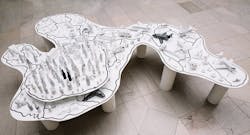It’s not common for someone to seemingly burst onto the interior design scene, but as the industry crowded into Momentum’s showroom during NeoCon 2016 to see Shantell Martin’s artwork displayed on the company’s textiles and annual tote bag, word of her work began to spread like wildfire.
It’s easy to see why. Martin’s use of negative and positive space in large-scale drawings is calming, although the ways in which the thick black lines fill your vision could otherwise seem overwhelming. The more you look, the more the whimsical drawing delves deep within to bring up existential questions such as, “Why now? Why how? Why you?”
That’s because for Martin—an artist trained in graphic design at St. Martin’s in London—drawing is a meditative experience, bringing her inner self out through pen on canvas. “We often feel as artists or creators that we need to go outside for inspiration,” she said. “We go to museums, we go to a show, we go to a convention center, we go on the internet, we look at books. We’re always looking outside for inspiration. But I think it’s really important to go inside because there’s a lot of inspiration naturally within us, and the way we draw that out as individuals is just by every day slowly trying to be a better version of ourselves.”
This use of drawing as a practical extension of her meditative practice began with her career as an artist in the club scene of Japan. Following her education at St. Martin’s, Martin packed for what she expected to be a year’s work in the Land of the Rising Sun teaching English to students. What emerged was the opportunity to create works to music in what she described as an avant-garde culture. In 2008, she again made an intercontinental move, this time to New York City, believing the work she was doing in Japan would easily translate into Manhattan galleries.
Instead, she found the art scene in New York difficult to break into, leading her to once again pick up markers. “I think [rejection from galleries] really encouraged me to use everything as my canvas,” Martin reflected. “Around that time I came up with this tag line: ‘Draw on everything!’ Metaphorically and physically. I’m going to draw on what I have access to. A lot of what we have access to is what we’re wearing, the rooms that we sleep in, friends’ cars, friends’ clothes, friends’ faces. I literally just drew on everything.”
Her use of “everything as a canvas” caught the eye of the New York Times’ Home and Garden editors who gave her large-scale drawings a cover story that garnered attention as a means of displaying artwork across interior products in a way that is calming and inviting. Soon Martin was offered the opportunity to work with companies like FLOS and Artek, covering their products with lines.
Her emergence in the interior design market spoke to people, as did her understanding of what constitutes a canvas. “I just decided to say, ‘Forget the art world,’” she explained, “and [instead] say, ‘Well, I’m going to say yes to projects that are a good fit to me, and say no to projects that aren’t a good fit to me.’ It doesn’t matter what world they’re in because, at the end of the day, we didn’t make those boxes or separations, so we shouldn’t have to work in just one world. We can work on any project that we like that is a good fit for us, and morally and ethically fit to us as artists.”
In staying true to her morals and ethics, Martin often finds herself working to nix the societally placed idea that while some of us can draw, others cannot. For Martin, when a child learns that their interpretation of a house, dog, or person is in some way wrong, they begin to compare themselves to those who are drawing these things “correctly,” and they believe they cannot draw. “It needs to be the reverse,” she said. “It needs to be, ‘How would you draw a dog? What does your dog or house or person look like?’ And really push that, and really understand our natural styles because it’s really important. That’s where we make the connection between our head and our hand and ourselves.”
She continued, “I would be really curious to see what the future looks like when we stop doing that to children and we stop telling them that they can’t draw, and we start telling them that they can draw, and they can draw in a way that is uniquely and recognizably theirs.”
About the Author

Kadie Yale
Former Editor-in-Chief
Kadie Yale holds a BA in Industrial Design from San Francisco State University and a MA in Decorative Art History and Theory from Parsons the New School. In her role as editor-in-chief from 2015-2018, she led the interiors+sources team in creating relevant content that touches on sustainability, universal design, science, and the role of design in society.
